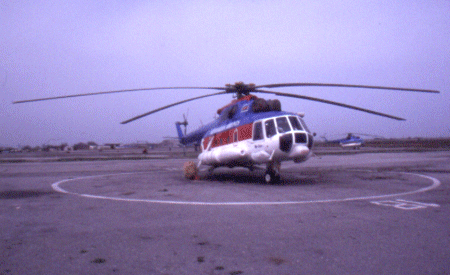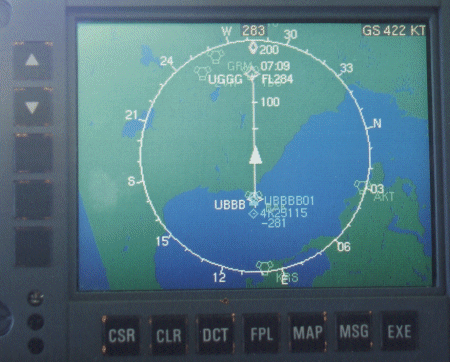Demand for air traffic will inevitably rise as the Caspian region taps in to potentially huge oil reserves
David Morrow/TBILISI and BAKU
Ultra-modern petrol stations stand out like gleaming ornaments amid the otherwise decrepit infrastructure of Tbilisi, Georgia. They are reminders - if any were needed - of where the money and power lies in the Caucasus and Caspian Sea regions. And as the Caspian region begins exploiting its potentially staggering oil and natural gas resources, air traffic demand will inevitably rise.
The present Caspian pipeline network and its air route network were originally designed to serve domestic interests and neither has adapted well to the post-Soviet era. Reconstructing the east-west Silk Road trade routes will demand a thorough airspace restructuring.
ICAO statistics show that the Southern Ring of nine former Soviet republics and Mongolia has just one-third the number of scheduled departures of Belgium alone.
Economic and geographic limitations are reflected in the Southern Ring's air traffic control infrastructure. Georgian civil aviation administration deputy chairman, Zurab Belkania, says: "The relief of Georgia is very complex. Mountains don't allow us to perform surveillance over our territory and it is not possible to have full radar coverage."
Although the Tbilisi area control centre now operates with a new airspace management system, the centre supervisor explains that the country still relies heavily on basic radio beacons, and adds that Georgia's radar network is prone to intermittent failure.
Deploying a conventional air traffic control network across the region, particularly over an area the size of Kazakhstan, is operationally impractical. While international air routes need to be supported, an air navigation infrastructure must also consider regional demographics such as the high proportion of rural inhabitants, local terrain and climate.
Rebuilding the Silk Road routes is also financially problematic. Funding for air route infrastructure often lags behind traffic demand. The Caspian region's subterranean wealth remains hostage to the region's own instability.
Kazakhstan and Azerbaijan have keenly invited multi-national consortia to sign lucrative oil exploration contracts. But although a new pipeline connecting Caspian Kazakhstan's Tengiz oil field to the Russian Black Sea port of Novorosiisk opened in March, political squabbling is blocking development of other trans-Caspian pipeline networks.
In the pipeline
US strategic forecasting centre Stratfor analyst Peter Zeihan says: "Azerbaijan's problem is that it doesn't have money. Infrastructure is needed for Western investment but the investment won't come without infrastructure."
Most controversial of the pipeline plans is the Baku-Ceyhan project to take oil from Azerbaijan through Georgia to Turkey for export. Already seen as threatening Russian influence on oil trunk routes, the pipeline must avoid regional conflicts such as the Azeri-Armenian dispute over Nagorno-Karabakh and separatist actions in Georgia.
"To get anything done requires co-operation from multiple states," says Zeihan. "Most plans involve at least four and this is a region notorious for countries not getting along."
Baku-Ceyhan would be comparable to the main Russia-Europe pipeline. This contributes $2 billion in annual transit fees to Ukraine, some 2% of the country's GDP. Georgia stands to lose enormously if Baku-Ceyhan is not built.
"Prospects for Georgia are very thin," says Zeihan. "With the pipeline Georgia would go from being one of the poorest countries to being awash in petroleum."
Addressing the needs of the Southern Ring for low-cost, easily-deployed air navigation infrastructure is the subject of a European Commission project. The scheme is funded by its Technical Assistance to the Commonwealth of Independent States (Tacis) programme.
Consultant Booz Allen & Hamilton senior associate Hemant Mistry says Southern Ring planners risk being pushed into trying to provide competitive aerial route efficiency in line with more advanced surrounding countries.
The Southern Ring project aims to overcome this by focusing on augmented satellite-positioning and automatic dependent surveillance-broadcast (ADS-B) concepts. Using technology developed by Swedish Civil Aviation Administration subsidiary Swedavia, an ADS-B ground station is inexpensive and could run on solar energy, making it ideal for deployment in remote areas lacking power connections.
"It potentially offers the opportunity for a technology leap and a navigation infrastructure that is able to cope with the traffic demand and overtake the 'catch-up' problem," says Mistry.
These efforts have culminated in a joint ADS-B demonstration between Georgia and Azerbaijan in late March to illustrate the concept's usefulness to the Southern Ring and prove that the technology is compatible with Russian-built aircraft in Caspian region fleets.
"We're trying to build a bridge between today's systems and the future," says Swedavia project director Sture Ericsson. "But we have to remember that what's good for Europe is not necessarily good for the Southern Ring."
Two Georgian Airlines aircraft - a Tupolev Tu-134 and a Tu-154 - took part in the demonstration, transmitting accurate position information to ground stations in Tbilisi and Baku, as well as to each other, via VHF datalink. The test has enabled ground observers to track aircraft and airport vehicles without the use of radar, and how air crews could use on-board cockpit displays to improve situational awareness and avoid surface and airborne conflicts.

During a Tbilisi-Baku charter flight the Tu-154's on-board displays also tracked two Azerbaijan Airlines Mil Mi-8 helicopters at low altitudes. Each was fitted with ADS-B systems.
Keeping up the momentum
While the demonstration proves the concept, the immediate difficulty is to keep the project's momentum going and hold Southern Ring co-operation together while convincing the European Commission that further funding is worthwhile.
Azerbaijan Air Navigation Services development department chief Elkhan Nakhmedov, who represents the Southern Ring in the air routes project, says: "It is a really big problem because it involves 10 different states. When the project started to go ahead I was more positive. However, I am afraid that if this thing is not pushed somehow, we lose this co-operation.
"I don't believe this region cannot afford the technology. But there are many political issues. Airlines choosing to move from secondary radar dependence to ADS-B would boost the cause. But if they don't then this is all just a good idea serving a limited purpose."

Immediate efforts will concentrate on setting up further ADS-B demonstrations and completing feasibility studies on implementation of augmented satellite-based navigation. These studies are based on the forthcoming European Geostationary Navigation Overlay Service (EGNOS) and Japan's Multi-function Trans-port Satellite Augmentation System (MSAS).
The navigation studies have put forward three candidate scenarios. The first has Southern Ring flights using EGNOS and MSAS for en route and non-precision approaches, eliminating the need to deploy dedicated regional systems except for precision approach operations.
In the second, additional EGNOS infrastructure could be deployed which, while more expensive, would improve the quality of available navigation data. The third scenario proposes duplicating EGNOS in its entirety and using additional local augmentation systems to maximise precision approach capability.
The idea is to create a Southern Ring area navigation environment, with specific performance requirements by 2006-9 - leading eventually to free-route airspace.
Source: Flight International
















